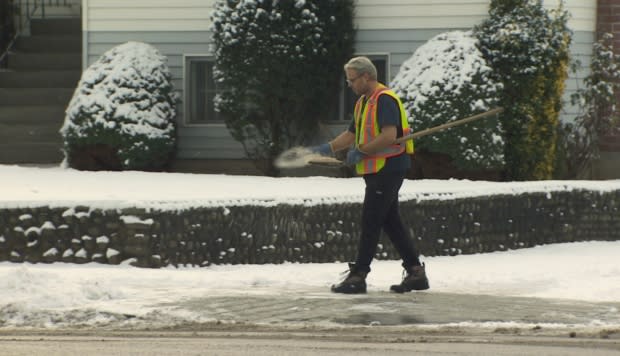Where the salt goes when the snow melts — and how much you should be using
With this week's snow and a round of freezing rain in the forecast, many streets and sidewalks in Vancouver have been covered with a layer of salt — a good thing for safety, experts say, but dangerous for the environment if it's overdone.
Egan Davis has more than 20 years' experience in snow and ice removal, both for the City of Vancouver and in the private sector.
He said the city is "fantastic" at using the right amount, but homeowners and businessowners often use too much.
"Especially, gosh, this last week ... the amount of salt that went down, in my observation, was extreme. The sidewalks were just white and caked with it," said Davis, who commutes around the city on foot or by bike. "I've seen people shaking bags out."

Davis, who also teaches horticulture at the University of British Columbia, said excess salt is simply bad for the environment.
"When it rains, [salt] runs off and leeches into the soil and it can burn the roots of plants — I've seen plants die from this," he said. "And it ends up washed into the storm drains, untreated."
Conservationists have also raised red flags about the effect road salt runoff has on salmon, saying saltier water in spawning streams can increase egg mortality and lead to deformities in adult fish. The mineral is also corrosive to cars and bad for your pets.
In Vancouver, trained city staff calibrate salting trucks so the right amount of grit goes on the roads.

And the right amount does need to go down, for the sake of safety — Vancouverites are required to clear snow and ice from their sidewalks by 10 a.m. every day, or face a fine. Business owners can also be held liable if someone slips, falls and injures themselves on an unsafe sidewalk.
The key, experts say, is using only what you need.
"We do work really hard to find a balance between safety and using too much," said Erin Hoess, manager of street operations for the city. "But we would ask that residents only use what's necessary."
'Walking across the salt flats'
Davis said a good rule of thumb for people at home is about a handful per square metre. For those who buy bagged products, it's best to read and follow the label as each product has a different rate.
He said you know if you've overdone it if you're crunching along the sidewalk.
"You shouldn't feel like you're walking across the salt flats," Davis said.
Both Davis and Hoess said it's best to lay salt down before it snows, but when the path is already a little damp.

Salt alternatives
Road salt works best in temperatures above –5 C, which is fine for balmy Vancouver, but inadequate for many cities and towns across Canada.
In Prince George, B.C., the winter months are often too cold for salt to be effective on the roads. Engineering staff use a mix of fractured rock and sand instead, saving salt for "critical" areas prone for slips and falls — like steps.
The rock and sand option is also cost effective: the grit is scooped back up off the roads in the spring to be reused when snow comes back in the fall.
"We just keep it in the public works warehouse until next time," said city spokesperson Mike Kellett.

Other wintry Canadian cities, like Calgary, are experimenting with other options like sticky, sweet-smelling beet brine. The reddish-brown mixture isn't corrosive to cars, unlike road salt, and works in conditions as cold as –20 C.
B.C. has also used beet brine on parts of the Coquihalla Highway where, again, it can be too cold for salt to work well.

